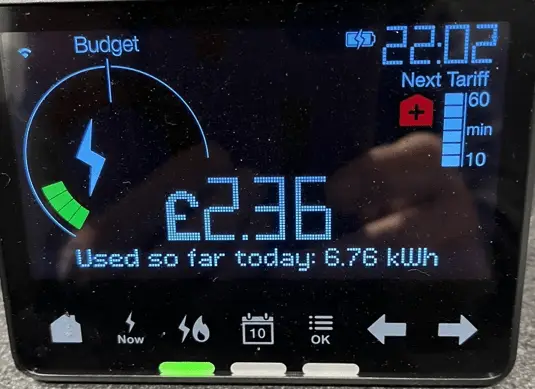
What are they?
Smart Meters replace conventional gas and electricity meters and have a communications module which automatically transmits meter readings using mobile phone signals (GSM) via a central hub to your energy supplier at 30 minute intervals. They also send a signal to an in house display (IHD) so you know in real time for electricity and at 30 minute intervals for gas just how much energy you are using and how much it is costing you. The illustration above also gives a warning of tariff change, RED indicating is I going to go up in about 60 minutes. The amount shown includes VAT and the standing charge, the latter is added at 00:00 hrs. There are other features which tell you how much you have used in the last week and month, depending on the type of IHD. The meters themselves are located in your old meter cupboard, garage etc.

Advantages for consumers
The main advantage to the consumer is that they know, using the IHD, the consumption and cost real time, this enables them to plan usage to take advantage of lower tariffs by delaying using such high energy devices like tumble dryers. They can be equipped with relay signals to switch night store heating and EV charging etc. on and off automatically as the price changes. It also enables consumers to take advantage of special rates offered by some energy suppliers at times of low demand (see later). It also means the end of estimated bills, sometime resulting in nasty shocks if the estimate was wrong. They are also essential for photovoltaic panels and enable households with battery storage as well to enjoy very favourable tariffs. All costs are covered by the energy supply companies
Advantages for the industry
The first advantage is that they do not have to take meter readings or rely on consumers to send the information. The main advantage energy suppliers get real time consumption data which aids planning and reduces the need to run up carbon intensive and expensive generating capacity. When combined with DFS (see below) really significant savings can be made in greenhouse gas emissions.
Demand Flexibility Service (DFS)
The DFS allows you to opt in and help the nation’s electricity system better handle peak electricity demand. These peak usage hours are typically from 16:00 to 19:00 but may vary depending on factors such as weather. Once you’ve opted in, your DFS provider would alert you in advance when they would like you to reduce your use of electricity during a DFS event. In future it should be possible to do this using home hubs such as Alexa to do the switching. Your supplier will then offer some form of reward, often in the form of cheap rates or sometimes free, at other times. Last year approximately 1.6 million households and businesses supported the service by shifting demand, saving over 3,300MWh of electricity, enough to power approximately 10 million homes across Great Britain or the output of the new Hickley Point C nuclear power station.
Problems
Most problems were associated with the old first-generation smart meters where each energy supplier had their own system. As they were generally incompatible it meant changing supplier usually also meant changing smart meter. Second generation meters are connected to a national communications system which then passes the data to your energy supplier so switching should be simple. The GB energy market is much more complex than anywhere else in Europe so there are many more points at which things can go wrong. The other big problems relate to GSM and Bluetooth signals. People in areas with poor GSM (mobile phone) signals find their data is not being received by the national communications system so it can’t be passed on to their supplier. In other cases, the design of houses, particularly old ones with stone walls means they can’t use an IHD as it can’t communicate with the actual meters.
The future
Without smart meters and a ‘smart grid’ we will not be able to manage the big increase in demand for electricity required by things like heat pumps and EVs, particularly as we will be relying much more on renewable energy. By changing unit costs as demand fluctuates consumers are encouraged to plan their use of electricity at times of low demand or high supply from renewable energy. Bluetooth enabled home hubs should hopefully help. There is nothing new in this concept as Economy 7 tariffs have been available for over 50 years and DFS is essentially just a more high-tech version.
When to plug in
Not smart metering but you may also be interested in the WhenToPlugIn app which shows you the live carbon intensity forecast and lets you know when the electricity in your home will be cleanest over the next 48 hours to help you plan your electricity usage. The app also offers a full breakdown of the energy sources powering the electricity in your region and provides live updates as new clean energy records are broken. See WhenToPlugIn App | National Grid Group
Written by Robert Skelton, member of the Ely Cathedral Environment Group
SRLS 24/06/24
